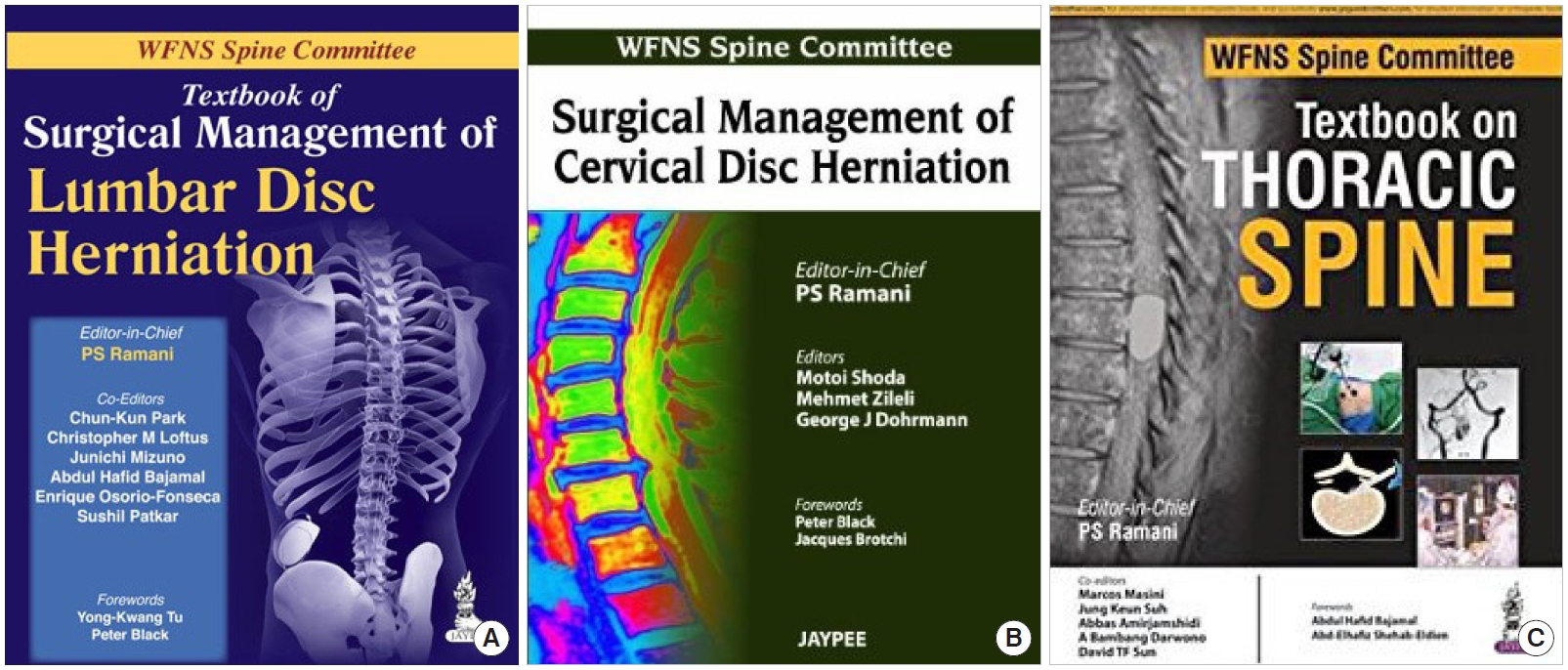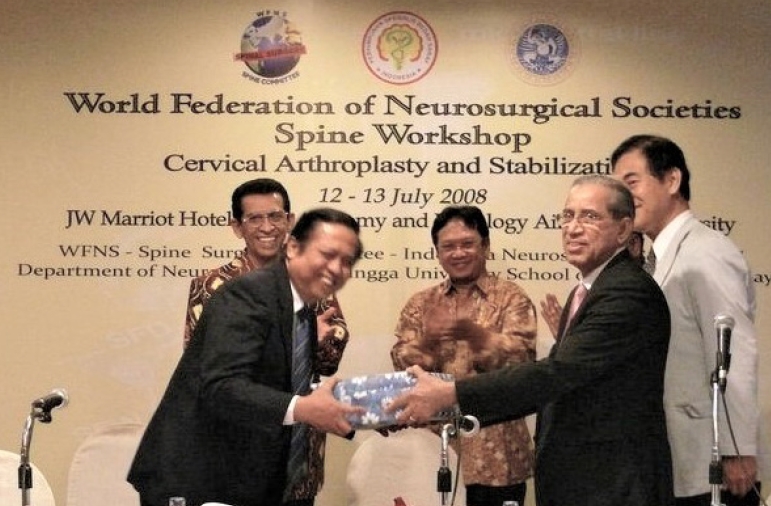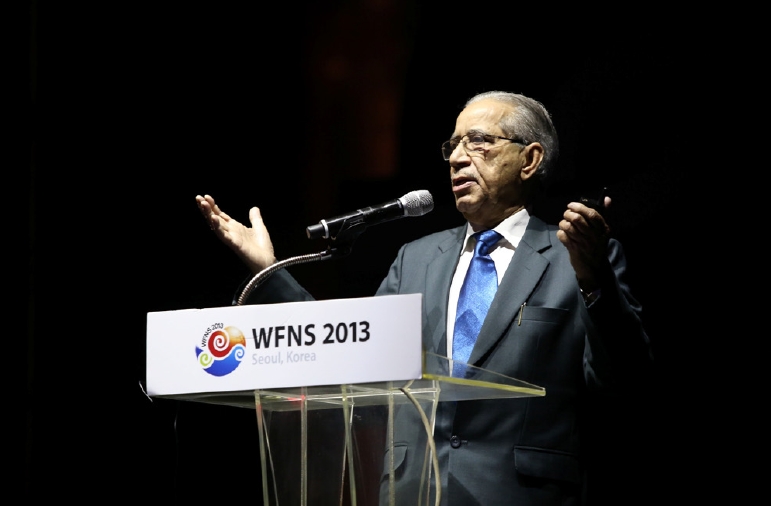 |
 |
- Search
|
|
||
This review paper will give a brief history of the spine surgery, and especially make remarks on the history of the World Federation of Neurosurgical Societies (WFNS) Spine Committee.
The history of spine surgery may be traced back to Egyptians. The description of fracture of cervical spine resulting in paralysis of the limbs due to accidents is found in Egyptian Papyrus (1550 BC) [1]. One thousand years later, Hippocrates (460–377 BC) documented a precise method for treating spinal fractures. This was followed by postural reduction of the kyphotic deformity developing late because of fractures [2,3].
Sir Percival Pott (1778) described opening of tuberculous paravertebral abscess and draining the cavity [4]. Until Lister (1882–1912) introduced antisepsis in the surgical procedures [5], infection was the main issue responsible for the slow progress of the spinal surgery.
The removal of disc tissue by doing laminectomy was advocated by Dandy (1890–1968) in the United States. The first laminectomy took place in 1829.
When Alban Gilpin Smith did the laminectomy in a patient with an old fracture, the patient recovered from progressive paresis in 1888 [6].
The beginning of successful spinal surgeries began when operations were done in aseptic conditions under general anesthesia.
Harvey Cushing operated on a patient with cauda equina syndrome [7]. The exploration was negative, but the patient had improved.
By 1932, the first operation carrying a preoperative diagnosis of a ruptured intervertebral disc was carried out by Mixter, a neurosurgeon, and Barr, an orthopedic surgeon [8]. A laminectomy from L2–S1 was done on a 28-year-old patient. A one cm mass was removed (sequestrated L4–L5 disc) with complete resolution of sciatica. In 1938, Love described intralaminar extradural approach to remove the disc [9,10]. This can be considered as the beginning of minimally invasive spine surgery using intralaminar approach.
Dr. R.B. Cloward, a neurosurgeon, always believed that following removal of intervertebral disc, interbody fusion should be done to achieve good long-term results, and he advocated vertebral body fusion [11]. In 1958, Cloward described an anterior cervical spine approach for removal of the disc followed by interbody fusion, which is now the most common approach [12]. The approach was also independently reported by Smith Robinson, an orthopedic surgeon [13]. Cloward has approached the spine from the right side while Robinson approached it from the left side.
The much needed biomechanical understanding of the functioning of the spine was provided by White et al. [14], Evans [15], Goel and Kim [16], and Benzel [17].
The modern spinal surgery developed with the introduction of Malis bipolar coagulator, surgical microscopes, and more delicate spinal instruments during the 1970s. Dr. Gazi Yasargil [18] and Dr. Williams [19] advocated a much smaller paraspinal incision and use of a microscope to access the intervertebral disc without disturbing the bony architecture of the spine.
Parviz Kambin in 1973 first introduced the birth of endoscopic spinal surgery by describing Kambin’s triangle [20,21] and endorsed by Hijikata et al. [22] in 1975. It is a transforaminal approach to disc from outside with access to both exiting and traversing nerve roots. From this beginning, a rigid endoscope evolved with an HD camera, drills, trephines, articulated graspers, and other instruments. Further developments aimed at reducing the diameter of the sheath and adding more sophisticated tools including radio frequency current and Holmium Lasers to make this surgery more palatable to the patients and surgeons. Newer developments include flexible endoscopes and dual approach endoscopic procedures.
Implants in spinal surgery became popular in the 9th decade of the last century but flourished immensely in the last decade making it as the decade of implants in spinal surgery [23].
By the year 2000, spinal surgery was well established. Technology was advancing at a very rapid pace, and surgeons made use of it to make the procedure very safe, comforting, and agreeable to the patients. From staying in the hospital for more than 2 weeks, modern spinal surgery had assumed the format of daycare surgery, with the patient returning to daily life as quickly as possible.
WFNS was founded in 1955 and included 119 national neurosurgical societies and 6 affiliated societies representing thirty thousand neurosurgeons worldwide [24]. A large congregation of neurosurgeons and with its popularity the number increased further compelling WFNS to form several committees representing each discipline in this science. It may be noted here that The President, First Vice-President, Secretary, President-Elect (only when in office), and the Coordinator of Committee Activities of the WFNS are ex-officio members of all committees. In practical reality, they remain very busy in the head office at Zurich and have not spent the desired time with committees.
Although, in principle, it was a good concept to start committees, unfortunately, there was not much liaison between the committees and academic activities of the WFNS.
Ad-hoc committees are founded in the 1980s, but the Spine Committee was created by Lyndsay Symon in 1993 [25]. Dr. H.A.D. Walder, in his book of WFNS history, mentions that the first chairperson starting in 1993 is Dr. Russell Hardy. But the members, and activities of the committee at those years are not well known.
Dr. P.S. Ramani has been a member of the WFNS Spine Committee since the year 2000. During the WFNS conferences (every 4 years in the absence of interim committees) a slot for 2 hours was provided for each committee in the venue of the conference to discuss administrative matters and there was no mention of academic participation of the committees with the WFNS program. Coffee was provided. Most of the meetings lacked luster and thus had become uninteresting. Dr. Ramani took over as the chairman in 2005 during WFNS conference in Morocco. His story for those days is narrated below:
“I still remember vividly that myself from India, George Dohrman from USA, Benny Wurjomartani from Indonesia were only members present waiting for the chairman to arrive. He took a long time. By then we had consumed 3 cups of coffee each. Finally, the chairman arrived only to announce that he was not interested in the post, nor in the membership of the committee and left in a huff. Such was the state of most committees. I knew that I had a herculean task ahead but decided to accept the challenge.
At that time, the committee was hardly known to any one as there was no academic activity. I spiralled the committee within a short time to such an active organization that WFNS committee declared that Spine Committee as the most active committee in the whole organization. What exactly did I do?
I managed to get as many representatives from different countries on the committee and to increase the interest of the members, I made sure that the WFNS spine committee administrative meetings are held in a hotel over lunch and a glass of wine. Truly enough representatives from many countries and particularly from India, South Korea, Japan, Indonesia, USA, South America etc. began vying with each other to become committee member. The practice of holding administrative meetings during academic programs in a hotel over lunch is still followed with much enthusiasm.
To propagate the knowledge of spinal surgery and to popularize WFNS Spine Committee, I organized several academic programs in various states of India as well as Kenya, Nigeria, South Africa, Indonesia, Malaysia, Bangladesh, Pakistan, South America, etc. Lot of interest was thus created in the committee’s other members and they also started holding academic activities regularly around the world and thus WFNS Spine Committee became a very popular discipline.
A logo was then prepared by my commercial artist which is being used regularly for the activities of the spine committee.
A website was quickly established and registered by me in India but WFNS head office (at that time) felt that each committee should not have a separate website.
On assuming the post of Chairman, the first thing I realized was the fact that Spine Committee did not have any representation in the scientific deliberations of WFNS conferences.
With continuous and persistent communication, with the main organization and organizing secretary of the academic activity, I managed to introduce scientific program into the main conference of WFNS. To start with, we were given a slot during lunch time. However, it worked to our benefit as by then spinal surgery had become very popular. The room allotted to us was so much crowded with delegates that many of them had to listen to the deliberations standing in the hall. Realizing the interest in spinal surgery I feel very happy and proud to note here that now we have significant representation in the academic programs of WFNS. However, I had some problems during WFNS conference in Brazil. The organizers had financial issues and they requested me to find a sponsor. I spoke to Dr Luiz Pimenta and he agreed. But at the last minute, he failed to provide the sponsor. I felt embarrassed but would not back out as I had already organized the scientific session. I spoke on the phone to Dr. Azavedo Filho and promised him to pay 5,000 US dollars from my pocket and I kept the promise and handed over the money to him in front of the then President of WFNS Dr. Peter Black. And the show went on.
I feel proud to mention that many of our members including myself have now delivered plenary session prestigious lectures in WFNS conferences and yet I felt that we should have much more academic representation in the WFNS programs, but knowing that this may not come forward easily, I decided to start our own independent meetings and I proposed independent biannual meetings for WFNS Spine committee much to the delight of all the members. The first meeting was held in Bali, Indonesia being sponsored by Dr. Abdul Hafid Bajamal, Professor and Head of the Department of Neurosurgery at Airlanga University in Surabaya in East Java. He donated 5,000 US dollars to WFNS from the proceeds of the conference. Subsequent meetings have been held regularly. Twelve years have passed and the sixth meeting will be held in Milano in 2021 with Maurizio Fornari of Humanitas Centre, organizing President (Table 1).
With cooperation from all the members of spine committee, I managed to publish 3 major textbooks for spine committee on Cervical, Thoracic and Lumbar spine with Indian publisher Jaypee Publications (Fig. 1).
I have established a basic set of spinal surgery instruments manufactured in India and at my request, the manufacturers (GESCO India) have already donated sets to Indonesia, Bangladesh, and 2 rural centers in India. It was approved by the WFNS (Fig. 2).
To train young neurosurgeons in spinal surgery, I held several cadaver workshops in India, Indonesia, Bangladesh, Kenya etc. with WFNS spine and the local faculty. These 2 days workshops were always very crowded and were well appreciated. Dr. Mehmet Zileli, the present chairman, was kind enough to be present in most of these workshops. The practice of holding cadaver workshops has been made mandatory in WFNS spine committee biannual meetings. Many of our members particularly, Dr. Enrique Osorio from Colombia, South America has been very active to hold such programs in their countries (Fig. 3).
At the end of 8 years, as chairman, I laid down my office in 2013 in WFNS conference in Seoul, Korea. I was satisfied that I could fulfil the challenge that I had accepted in 2005 and had converted WFNS spine committee into a very academic powerful organization in the world. After 2013, I have still remained very active. During my tenure as chairman, the spine committee has deposited in the kitty of WFNS more than 50,000 US dollars from the proceedings of our biannual conferences. The major contribution came from Dr. Christopher Loftus and Dr. Bong Soo Kim from USA.
I was involved in the committee to hold consensus meets to establish guidelines for spinal pathologies. The most memorable and the first consensus meet on cervical spine degenerative diseases was held in Nagpur, India in 2018 under the aegis of NSSA. Many of its recommendations are published in the Neurospine Journal - a journal which is now approved as the official journal of Spine Committee.”
Since it is his prerogative, the president of WFNS Yong-Kwang Tu, appointed Dr. Enrique Osorio as the Chairman of Spine Committee in 2013. The new WFNS President in 2017, Dr. Franco Servadei had a wider vision, and he felt that the spine committee is so big that it will be impossible for one chairman to look after its affairs. He preferred to appoint one chairman (Dr. Mehmet Zileli) and 2 cochairmen. Indeed, the committee has become so vast and powerful that many more activities have now introduced including webinars, 2 consensus meetings already held, and the 3rd one being organized in India’s recent future. The members have now become very active and propagate the concepts of spine committee all over the world. An active website is working http://wfns-spine.org/, of which webinars and recommendations of the committee are regularly published. A newsletter is being published with editorship of Dr. Oscar L. Alves from Portugal. The committee is also working to implement a curriculum and courses on basic and advanced levels (Table 2).
ACKNOWLEDGEMENTS
We appreciate the contributions of all past and present members of the WFNS Spine Committee.
Fig. 1.
Covers of 3 books published by the WFNS Spine Committee. WFNS, World Federation of Neurosurgical Societies.

Fig. 2.
WFNS Spine Committee was donating a set of spinal surgery instruments to Indonesia. WFNS, World Federation of Neurosurgical Societies.

Fig. 3.
Professor Ramani during WFNS 2013 meeting in Seoul. WFNS, World Federation of Neurosurgical Societies.

Table 1.
The list of WFNS Spine Committee biannual meetings
Table 2.
Past chairpersons and current list of members of the WFNS Spine Committee
REFERENCES
1. Deines H, Grapow H, Westendorf W. Grundriss der Medizin der alten A ¨gypter. 5 Bd. Berlin: Akademie Verlag; 1958.
2. Fuchs R. Hippokrates, samtliche Werke. 3Bd. München: Verlag von H. Lüneburg; 1900.
3. Fuchs R. Geschichte der Heilkunde bei den Griechen. In: Neuburger M, Pagel J editors. Handbuch der Geschichte der Medizin. Jena: G: Fischer; 1902.
5. Lister J, Herschfeld JJ. Joseph Lister and the principle of antiseptic surgery. 1867. Bull Hist Dent 1988 36:120-6.

6. Keller T, Holland MC. Some notable American spine surgeons of the 19th century. Spine 1997 22:1413-7.


7. Goldthwait J, Osgood R. A consideration of the pelvic articulations from an anatomical, pathological and clinical standpoint. Boston Med Surg J 1905 152:365-72.

8. Mixter W, Barr J. Rupture of the intervertebral disc with involvement of the spinal canal. N Engl J Med 1934 211:210-5.

9. Love J. Removal of protruded intervertebral disc without laminectomy. Proc Staff Meet Mayo Clin 1939 14:800-5.
10. Love J, Walsh M. Protruded intervertebral disks. Report of one hundred cases in which operation was performed. JAMA 1938 111:396-400.

11. Cloward RB. The treatment of ruptured lumbar intervertebral discs by vertebral body fusion. I. Indications, operative technique, aftercare. J Neurosurgery 1953 10:154-68.
12. Cloward RB. The anterior approach for removal of ruptured cervical disks. J Neurosurg 1958 15:602.


13. Robinson RA, Smith G. Anterolateral cervical disc removal and interbody fusion for cervical disc syndrome. Bull Johns Hopkins Hosp 1955 96:223.

14. White AA, Johnson RM, Panjabi MM, et al. Biomechanical analysis of clinical stability in the cervical spine. Clin Orthop Relat Res 1975 109:85-96.

16. Goel VK, Kim YE. Effects of injury on the spinal motion segment mechanics in the axial compression mode. Clin Biomech (Bristol, Avon) 1989 4:161-7.


17. Benzel EC. Biomechanics of spine stabilization. New York: Thieme Medical Publishers, Inc; 2014.
19. Williams RW. Microlumbar discectomy. A conservative surgical approach to the virgin herniated lumbar disc. Spine 1978 3:175-82.


20. Kambin P. Percutaneous lumbar discectomy: current practice. Surg Rounds Orthop 1988 31-5.
21. Tumialán LM, Madhavan K, Godzik J, et al. The history of and controversy over Kambin's triangle: a historical analysis of the lumbar transforaminal corridor for endoscopic and surgical approaches. World Neurosurg 2019 123:402-8.


22. Hijikata S, Yamagishi M, Nakayama T, et al. Percutaneous diskectomy: a new treatment method for lumbar disc herniation. J Toden Hosp 1975 5:5-13.
23. Epstein NE. Iliac crest autograft versus alternative constructs for anterior cervical spine surgery: Pros, cons, and costs. Surg Neurol Int 2012 3(Suppl 3):S143-56.



24. Van Alphen HA. 50 years of the World Federation of Neurosurgical Societies (1955-2000) [Internet]. Nyon (Switzerland), WFNS. [cited 2021 Mar 13]. Available from: https://www.wfns.org/menu/12/learn-more-about-wfns.
25. Walder HAD. History of WFNS [Intetnet]. Nyon (Switzerland), WFNS. [cited 2021 Mar 13]. Available from: https://www.wfns.org/menu/5/wfns-history.

- TOOLS
-
METRICS

-
- 1 Web of Science
- 0 Crossref
- Scopus
- 4,721 View
- 146 Download
- Related articles in NS
-
Rehabilitation of Spinal Cord Injury: WFNS Spine Committee Recommendations2020 December;17(4)
Outcomes of Spinal Cord Injury: WFNS Spine Committee Recommendations2020 December;17(4)
History of Spinal Neurosurgery and Spine Societies2020 December;17(4)
Recommendations of WFNS Spine Committee2019 September;16(3)
History of Korean Spinal Neurosurgery Society2018 September;15(3)
-
Journal Impact Factor 3.2


























